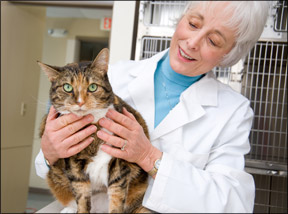The good news is that cats are living longer these days, thanks largely to advances in feline nutrition and veterinary medicine in general. The bad news, however, is that these longer life spans give cats a greater chance of developing arthritis – a painful, 288 debilitating and potentially crippling joint disease that is predominantly age-related. All Too Common. In a study conducted a few years ago, researchers carefully analyzed X-rays of the spines and limbs of 100 middle-aged or elderly cats (10 years of age or older). The X-rays revealed that 90 percent of cats over age 12 showed clearly discernible radiographic signs of arthritis. But this is not to say that older cats are exclusively at risk for this joint disorder. Another study, based on postmortem examination of shelter cats, indicated that one out of five cats one year of age and older in this population – despite their relative youth – were arthritic to some extent. In any case, the condition is chronic and incurable. Once a cat is diagnosed with arthritis, the disease is usually manageable to a degree by means of medical therapy or surgery. But once present, it is unfortunately never totally curable. Wear and Tear. Arthritis comes in a variety of forms and can be precipitated by wide-ranging factors, including genetically acquired predisposition, congenital malformation, physical trauma, immune system malfunction and even infectious disease. Most commonly, however, feline arthritis simply results from the constant wear and tear that the joints experience during the course of a typically active cats daily life, says Christine Bellezza, DVM, a consultant at Cornell Universitys Feline Health Center. While the sources of the condition vary, they all eventually lead to inflammation within the joints, changes in their anatomical makeup, pain and an inevitable decline in the ability of the associated bones, muscles, tendons and ligaments to function properly. The most common form of feline arthritis, says Dr. Bellezza, is osteoarthritis, otherwise known as degenerative joint disease. This condition is characterized by the erosion of cartilage, the smooth tissue that protects the ends of bones from rubbing directly against one another within a movable joint. When this protective tissue is worn or torn away completely, the bone ends come into immediate contact, and the persistent grinding of bone against bone results in inflammation and pain. All joints in a cats body can be affected by osteoarthritis. While those that will become most visibly apparent to the owner are the movable joints, most often the shoulders and elbows, the knees (stifles), the wrists (carpi) and the hips are also frequently affected. The outward signs will vary, depending on which joints are most painful, the extent of damage, and the animals age. An altered gait may eventually occur as the disease progresses or if the joint disorder has resulted from an injury. Although osteoarthritis most commonly results from the constant grinding of bone ends over a long lifetime, Dr. Bellezza points out that the condition can also emerge in younger cats as the result of hip dysplasia, a genetically acquired malformation in which the ball-and-socket joint connecting the top end of the thigh bone and the cavity in the hip into which it is supposed to fit are improperly aligned. As a result, the bones in the joint knock and grind against each other, which can eventually lead to the wear and tear characteristic of osteoarthritis. Risk Factors. There is no gender predisposition for feline arthritis; males and females of all breeds are similarly susceptible. Overall, experts agree that advanced age is by far the greatest risk factor. Also of significance, Dr. Bellezza emphasizes, is an animals weight, since fat cats are constantly exerting excessive pressure on their vulnerable load-bearing joints. (This is especially problematic considering the growing problem of feline obesity. Recent research on the subject suggests that between 30 percent and 35 percent of cats living in U.S. households are grossly overweight.) Regarding lifestyle as a risk factor, she notes that outdoor cats may be at greater risk than indoor cats for arthritis because of their increased vulnerabilty to joint-damaging injury – being struck by a car, for example. At the same time, she notes, indoor cats are not without risk just because theyre more sedentary and underexercised. “Some activity is beneficial to joint function,” she observes. No matter what has caused the condition, the signs of arthritis are similar. A formerly agile and athletic cat will become increasingly reluctant to leap up onto a sofa or windowsill or to scamper up and down stairs. It will typically become quieter and more sedentary. Its appetite may diminish, and it will tend to spend more of its time in one spot. A severely arthritic cat will also indicate that it is in pain when its lower back or limbs are touched. Due to persistent discomfort and joint immobility, some animals will become less fastidious when it comes to cleaning themselves thoroughly or using the litter box. On the other hand, Dr. Bellezza points out, some affected cats – no matter how much pain they are experiencing – may skillfully conceal their discomfort. Presumably due to a deeply ingrained instinct for self-protection, they will avoid signaling to potential predators that they are in any way disabled. “Cats can be kind of tricky in that respect,” she notes. Addressing the Problem. In many instances, a routine veterinary checkup may reveal that a cat is suffering from early-stage, if not advanced, arthritis – and the earlier that the condition is diagnosed, the better are the chances that its resultant pain and disability can be alleviated. Veterinary diagnosis of a cat that seems to be experiencing arthritic pain, says Dr. Bellezza, focuses on excluding other disorders and, insofar as possible, confirming the presence of osteoarthritis or other types of joint disease. This will entail a complete medical history and overall physical examination of the affected animal. If the signs of arthritis are present, the physical exam will be followed by X-rays – and possibly other imaging techniques – which may provide definitive indications of arthritis. Treatment for feline osteoarthritis, she says, usually entails weight loss for obese cats, gentle exercise, environmental modifications and pain control. Helping the cat to avoid painful situations by moving food dishes and litter boxes to easily accessible locations and devising ways to avoid the need for leaping to high places can be of great help. Many arthritic cats will also appreciate warm areas in which to rest. Nutraceutical compounds such as glucosamine and chondroitin are frequently prescribed first. “These medications can take months before they start to work,” says Dr. Bellezza, “but a lot of arthritic cats will eventually show signs of improvement, and these medications are virtually without side effects.” If these agents fail to relieve the animals pain, further options include the use of anti-inflammatory drugs, although these agents can have significant side effects in cats and their use must be carefully supervised by a veterinarian. Surgical options are available for certain types of arthritis, she points out, including bone-fusion procedures for select joints. Although these surgeries tend to be regarded as last-ditch efforts and can be expensive, Dr. Bellezza notes that they often provide excellent pain relief. Although feline osteoarthritis is a progressive disease, the progression can be slowed, and most cats can be made more comfortable by a combination of lifestyle changes, weight control, nutritional supplements and pain medications.



